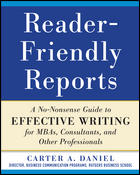“Reader-Friendly Reports” in a nutshell
For a quick primer on writing great reports, simply read the following paragraph by Carter A. Daniel.
The people who assigned you the report did so because they didn’t have the time to do the work themselves. They asked you the questions, and now they want the answers. The answers, therefore, are the most important things in your report, and you must organize your whole report around those answers and wave them in your readers’ faces. State the answers at the beginning; elaborate on them one by one in the rest of the report; include only things that pertain to these answers; and be sure that the pertinence is always clear. Reread this paragraph.
If you can follow this advice, given by Daniel in Reader-Friendly Reports, p. 5, you can write a great report. If you need help, the author provides detailed instructions in the rest of the book.
Daniel’s sense of humor enlivens a book that might otherwise be dry. For example, he writes, “Footnotes don’t make something research. If you put footnotes on a piece of garbage, it’s still garbage,” (page 119).
He’s also practical; he doesn’t insist on esoteric practices for the sake of being “correct.” A realist about corporate life, Daniel says, “Nothing here is ‘correct’ if your boss told you to do it another way” (page 193).
The three key sections of this book are
- Planning a Reader-Friendly Report—I agree with Daniel that planning is the most important step.
- Writing a Reader-Friendly Report—I love the sub-sections about understandability, organized paragraphs, and strong sentences and clear style. The rest of this section overlaps with a good book about grammar, punctuation, and other usage questions.
- Research Techniques—The myths and realities subsection is a “must read.”
In my opinion, the book would have been complete with just these three sections. However, the author also includes sections on “Other Things,” Sample Reports,” “The Appearance of the Finished Document,” and checklists. The good news? You can grasp the author’s most important points in just 147 pages.
Disclosure: I received a free copy of this book from McGraw-Hill in return for agreeing to write about it.


Great post! I write a LOT of reports, and probably think mine can’t be improved a whole lot, but my guess now is that they probably can! I look forward to getting a copy of this book; and, referncing your post in my blog! Thanks!!!
Dave,
I’m glad you enjoyed my post enough to buy the book.
Thank you!